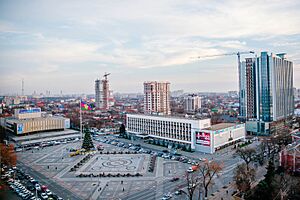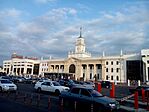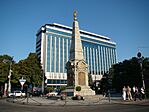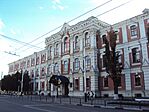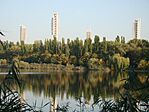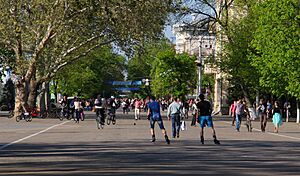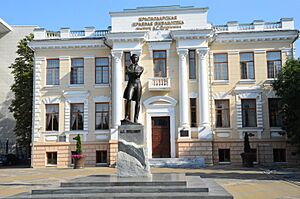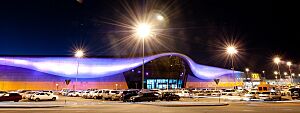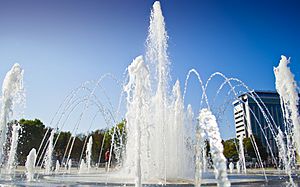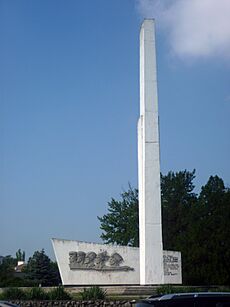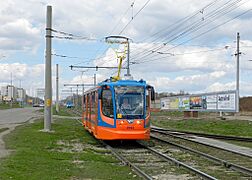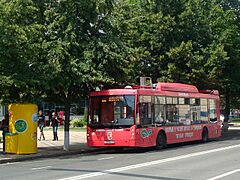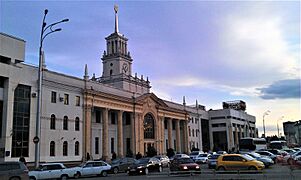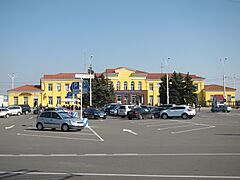Krasnodar facts for kids
Quick facts for kids Krasnodar (English)Краснодар (Russian) |
|
|---|---|
| - City - | |
| [[File:
From the top to the left: Theatre's Square, Krasnodar-1 railway station, Obelisk, Medical Academy, Pokrovsky Pond (Karasun), Krasnodar Park
|250px]] |
|
|
|
|
| Anthem | Anthem of Krasnodar |
| City Day | Last non-working day of September |
| Administrative status | |
| Country | Russia |
| Federal subject | Krasnodar Krai |
| Administratively subordinated to | City of Krasnodar |
| Municipal status | |
| Urban okrug | Krasnodar Urban Okrug |
| Mayor | Yevgeny Naumov |
| Representative body | City Duma |
| Statistics | |
| Population (2010 Census, preliminary) |
744,995 inhabitants |
| - Rank in 2010 | 12th |
| Population (2024 est.) | 1,138,654 inhabitants |
| Time zone | MSK (UTC+04:00) |
| Founded | January 12, 1794 |
| City status since | 1867 |
| Postal code(s) |
List
350000–350005, 350007, 350010–350012, 350014–350016, 350018–350020, 350033, 350035, 350038–350040, 350042, 350044, 350047, 350049, 350051, 350058, 350059, 350061–350067, 350072, 350075, 350078, 350080, 350086–350090, 350500, 350880, 350890, 350899–350901, 350910–350912, 350931, 350960, 350961, 350963–350965, 350991–350999 |
| Dialing code(s) | +7 861 |
| Official website: http://www.krd.ru | |
Krasnodar is a large city in southern Russia. It's the main city of Krasnodar Krai. The city is located on the Kuban River and has over 1.1 million people. In recent years, Krasnodar has grown very quickly. It is now the 13th largest city in Russia. It's also the second largest city in southern Russia.
Krasnodar started in 1793 as a fort built by Cossacks. It soon became an important trading center. The city was badly damaged during World War II but was rebuilt. Today, Krasnodar is a major economic hub in southern Russia. In 2012, Forbes magazine even called it the best city for business in Russia. Krasnodar has many interesting places to visit, including the Krasnodar Stadium. Its main airport is Krasnodar International Airport.
Contents
- City Name: What Does Krasnodar Mean?
- Krasnodar's History
- Geography and Climate
- Population of Krasnodar
- Economy: Business in Krasnodar
- Culture and Arts
- Main Sights and Attractions
- Sports in Krasnodar
- Transportation Around Krasnodar
- Education in Krasnodar
- Krasnodar's Coat of Arms
- Famous People from Krasnodar
- International Connections
- Images for kids
- See also
City Name: What Does Krasnodar Mean?
Krasnodar was founded on January 12, 1794. Its first name was Yekaterinodar. This name meant "Catherine's Gift." It honored Catherine the Great, who gave land in the Kuban region to the Black Sea Cossacks. It also honored Saint Catherine of Alexandria, who is seen as the city's protector. The city officially became a city in 1867.
On December 7, 1920, after the October Revolution, Yekaterinodar was renamed Krasnodar. The new name means "Gift of the Reds." The word Krasno- can mean 'red' (like for Communism) or 'beautiful'. Dar means 'gift'.
Krasnodar's History
Krasnodar began as a military camp in 1793. It was built as a fortress by the Cossacks. Their job was to protect the borders and show Russia's control over the area. In the early 1800s, Yekaterinodar grew into a busy center for the Kuban Cossacks. It became an official town in 1867. By 1888, about 45,000 people lived there. It was a key trading spot in southern Russia.
During a time of civil unrest in Russia (1917-1922), the city was controlled by different groups. Many Kuban Cossacks supported the anti-Bolsheviks.
During World War II, the German Army occupied Krasnodar from August 9, 1942, to February 12, 1943. The city was heavily damaged during the fighting. After the war, it was rebuilt and made new again. In 1943, trials were held in Krasnodar for people who had worked with the Nazis.
In 1971, a bomb exploded on a bus in the city. It was placed by a mentally ill person. This sad event killed 10 people and injured many others.
Geography and Climate
Krasnodar is the largest city in Krasnodar Krai by population. It is located on the right bank of the Kuban River. Moscow, the capital of Russia, is about 1300 km (800 miles) to the north. The Black Sea is about 120 km (75 miles) to the west.
Climate in Krasnodar
Krasnodar has a humid subtropical climate. This means it has hot, humid summers and mild winters. It's similar to the climate in New York City.
Winters are usually cold and wet, with some snow. The average temperature in January, the coldest month, is about 1°C (34°F). Winter weather can change a lot. Temperatures can sometimes go above 20°C (68°F) for a few days. But it can also get very cold, below -20°C (-4°F). This is because mountains don't protect the city from cold air. Summers are typically hot, with an average temperature of 24.1°C (75.4°F) in July.
The city gets about 735 mm (29 inches) of rain each year. This rain is spread out fairly evenly throughout the year. Very strong storms are rare. The highest temperature ever recorded was 40.7°C (105.3°F). The lowest was -32.9°C (-27.2°F).
| Climate data for Krasnodar (1991–2020, extremes 1881–present) | |||||||||||||
|---|---|---|---|---|---|---|---|---|---|---|---|---|---|
| Month | Jan | Feb | Mar | Apr | May | Jun | Jul | Aug | Sep | Oct | Nov | Dec | Year |
| Record high °C (°F) | 20.8 (69.4) |
23.1 (73.6) |
28.5 (83.3) |
34.7 (94.5) |
35.1 (95.2) |
39.3 (102.7) |
40.7 (105.3) |
40.0 (104.0) |
38.5 (101.3) |
33.9 (93.0) |
28.5 (83.3) |
23.0 (73.4) |
40.7 (105.3) |
| Mean daily maximum °C (°F) | 4.5 (40.1) |
6.7 (44.1) |
11.8 (53.2) |
18.6 (65.5) |
23.9 (75.0) |
28.2 (82.8) |
31.1 (88.0) |
31.4 (88.5) |
25.6 (78.1) |
19.0 (66.2) |
11.2 (52.2) |
6.4 (43.5) |
18.2 (64.8) |
| Daily mean °C (°F) | 0.8 (33.4) |
1.9 (35.4) |
6.5 (43.7) |
12.4 (54.3) |
17.9 (64.2) |
22.2 (72.0) |
24.9 (76.8) |
24.7 (76.5) |
19.2 (66.6) |
12.9 (55.2) |
6.3 (43.3) |
2.4 (36.3) |
12.7 (54.9) |
| Mean daily minimum °C (°F) | −1.9 (28.6) |
−1.5 (29.3) |
2.7 (36.9) |
7.4 (45.3) |
12.9 (55.2) |
17.0 (62.6) |
19.4 (66.9) |
18.9 (66.0) |
13.8 (56.8) |
8.4 (47.1) |
2.9 (37.2) |
−0.4 (31.3) |
8.3 (46.9) |
| Record low °C (°F) | −32.9 (−27.2) |
−29.8 (−21.6) |
−25.5 (−13.9) |
−5.6 (21.9) |
−1.2 (29.8) |
4.2 (39.6) |
9.5 (49.1) |
3.9 (39.0) |
−2.2 (28.0) |
−9.9 (14.2) |
−20.4 (−4.7) |
−27.6 (−17.7) |
−32.9 (−27.2) |
| Average precipitation mm (inches) | 65 (2.6) |
53 (2.1) |
65 (2.6) |
49 (1.9) |
65 (2.6) |
80 (3.1) |
66 (2.6) |
41 (1.6) |
51 (2.0) |
61 (2.4) |
66 (2.6) |
69 (2.7) |
731 (28.8) |
| Average extreme snow depth cm (inches) | 3 (1.2) |
4 (1.6) |
1 (0.4) |
0 (0) |
0 (0) |
0 (0) |
0 (0) |
0 (0) |
0 (0) |
0 (0) |
1 (0.4) |
2 (0.8) |
4 (1.6) |
| Average rainy days | 13 | 11 | 14 | 15 | 14 | 14 | 10 | 8 | 10 | 12 | 14 | 15 | 150 |
| Average snowy days | 11 | 10 | 6 | 0.3 | 0 | 0 | 0 | 0 | 0 | 0 | 3 | 9 | 39 |
| Average relative humidity (%) | 81 | 76 | 72 | 66 | 66 | 68 | 63 | 62 | 68 | 75 | 81 | 82 | 72 |
| Mean monthly sunshine hours | 71 | 84 | 136 | 181 | 247 | 277 | 303 | 286 | 238 | 173 | 88 | 55 | 2,139 |
| Source 1: Погода и Климат | |||||||||||||
| Source 2: NOAA (sun, 1961–1990) | |||||||||||||
Population of Krasnodar
| Historical population | ||
|---|---|---|
| Year | Pop. | ±% |
| 1897 | 65,606 | — |
| 1926 | 158,460 | +141.5% |
| 1939 | 203,806 | +28.6% |
| 1959 | 313,110 | +53.6% |
| 1970 | 464,147 | +48.2% |
| 1979 | 560,438 | +20.7% |
| 1989 | 620,516 | +10.7% |
| 2002 | 646,175 | +4.1% |
| 2010 | 744,995 | +15.3% |
| 2021 | 1,099,344 | +47.6% |
| Source: Census data | ||
In 1897, when it was called Yekaterinodar, the city had 65,606 people. Most of them spoke Russian or Ukrainian. By 1916, the population grew to over 100,000.
Today, Krasnodar is a very fast-growing city. According to the 2021 census, its population is 1,099,344 people. This is a big increase from 744,995 people in 2010.
Economy: Business in Krasnodar
Krasnodar is a very important economic center in southern Russia. Forbes magazine has even called it the best city for business in Russia. The city has over 130 large and medium-sized businesses.
The main industries in Krasnodar are:
- Agriculture and food production: This makes up almost half of the city's economy.
- Energy: Producing power for the city and region.
- Fuel: Dealing with oil and gas.
- Machine building: Creating different types of machines.
- Forestry and chemical industries: Working with wood and chemicals.
Krasnodar is also a big place for shopping and trade. It has the highest number of malls per person in Russia. Even during tough economic times, the amount of goods sold in Krasnodar kept growing. The city also has a very low unemployment rate. This means most people who want to work can find jobs. The average salary in Krasnodar is also quite high.
Tourism is another important part of Krasnodar's economy. There are more than 80 hotels in the city. The Hilton Garden Inn, which opened in 2013, was the first international hotel there.
Culture and Arts
The oldest part of Krasnodar is its Historic Center. It has many old buildings, some from the 1800s. These buildings have been saved and fixed up. This area is now a popular place for tourists to visit.
Krasnodar has many great places for theater and performances:
- The Gorky Krasnodar State Academic Drama Theater
- The Krasnodar Ballet Theater
- The Krasnodar Regional Puppet Theater (for puppet shows!)
- The Krasnodar Musical Theater
- The Krasnodar State Circus
- The Ponomarenko Krasnodar Philharmonic, known for its amazing sound.
- The Kuban Cossack Choir, which performs traditional Cossack songs and dances.
The city also has several important museums. The Kovalenko Krasnodar Regional Art Museum is the oldest public art museum in the North Caucasus region. It has a wonderful collection of art.
The biggest public library in Krasnodar is the Pushkin Krasnodar Regional Universal Scientific Library. It was started in 1900.
Main Sights and Attractions

Krasnodar is home to a cool steel tower called the Hyperboloid Tower. It was built by a Russian engineer named Vladimir Shukhov in 1928. You can find it near the Krasnodar Circus.
Other interesting places to see include:
- St. Catherine's Cathedral
- The State Arts Museum
- A park and theater named after Maxim Gorky
- The concert hall of the Krasnodar Philharmonic Society, which has some of the best sound in southern Russia.
- The State Cossack Choir and the Krasnodar circus.
The most famous street in Krasnodar is Krasnaya Street, which means "Red, Beautiful Street." Many of Krasnodar's sights are on this street. At one end, you'll find the Central Concert Hall. At the other end is the Avrora cinema center. There's also a "Triumphal Arch" in the middle of Krasnaya Street.
Theater Square has the largest splash fountain in Europe! This amazing fountain was opened on September 25, 2011, during the city's celebration day.
Another famous spot is Krasnodar Park, also called Galitsky Park. It's a large city park in the northeast of Krasnodar. It's right next to the FC Krasnodar stadium. A businessman named Sergey Galitsky paid for the park, and it opened on September 28, 2017. The park is huge, covering 22.7 hectares (about 56 acres). It has more than 2,500 trees, including oak, maple, pine, and even bonsai trees!
Sports in Krasnodar
Krasnodar is a city that loves sports! Many professional sports teams play here:
| Club | Sport | Founded | Current League | League Level |
Stadium |
|---|---|---|---|---|---|
| Kuban Krasnodar (defunct) | Football | 1928 | — | ||
| FC Krasnodar | Football | 2008 | Premier League | 1st | Krasnodar Stadium |
| WFC Krasnodar | Football | 2020 | Women's Supreme Division | 1st | Krasnodar Academy Stadium |
| Kubanochka Krasnodar (defunct) | Football | 1988 | — | ||
| Urozhay Krasnodar | Football | 2018 | PFL | 3rd | Kuban Stadium |
| Lokomotiv Kuban | Basketball | 2009 | VTB United League | 1st | Basket Hall |
| Kuban Krasnodar | Rugby union | 1996 | Professional Rugby League | 1st | Trud Stadium |
| Kuban Krasnodar (defunct) | Ice hockey | 2012 | — | ||
| Dinamo Krasnodar | Volleyball | 1994 | Volleyball Super League | 3rd | Olimp Sports Palace |
| Dinamo Krasnodar | Volleyball | 1946 | Women's Volleyball Super League | 1st | Olimp Sports Palace |
| SKIF Krasnodar | Handball | 1963 | Handball Super League | 1st | Olimp Sports Palace |
| Kuban Krasnodar | Handball | 1965 | Women's Handball Super League | 1st | Olimp Sports Palace |
| Krasnodar Bisons | American Football | 2006 | League of American Football | 1st | UTB Kuban |
Transportation Around Krasnodar
In Krasnodar, like many big cities in Russia, most people use cars to get around. But the city is also working to make other ways of travel easier. They are planning new light railways and building more bike paths and wide sidewalks.
Public transportation in Krasnodar includes city buses, trolleybuses, trams, and marshrutkas (which are like shared taxis). Trolleybuses and trams are powered by electric wires overhead. They are the main way people get around the city, as Krasnodar does not have a subway system.
The main airport is Krasnodar International Airport. The biggest airlines operating there now are Aeroflot and Rossiya Airlines. The city also has two railway stations: Krasnodar-1 and Krasnodar-2.
Education in Krasnodar
Krasnodar has many schools for students of all ages. There are 15 gymnasiums (schools focused on academic subjects), 5 lyceums (schools that prepare students for higher education), and 110 general education schools. There are also 20 specialized schools and 7 private schools.
The city is home to many universities and colleges. Some of the main ones include:
- Kuban State University
- Kuban State Technological University
- Kuban State Agrarian University
- Kuban State Medical University
There is also the Marketing and Social Technology University of Krasnodar.
Krasnodar's Coat of Arms
The coat of arms for Yekaterinodar (Krasnodar's old name) was created in 1841. The letter "E" in the middle stands for Ekaterina II, which is Catherine the Great. It also shows the year the city was founded. The Imperial double headed eagle is a symbol of the Tsar's support for the Black Sea Cossacks. There's also a Cossack leader's staff (a bulawa), the Yekaterinodar fortress, and flags with letters "E", "P", "A", and "N". These letters stand for different Russian rulers: Catherine II, Paul I, Alexander I, and Nicholas I. The yellow stars around the shield represent the 59 Black Sea Cossack villages around the city.
Famous People from Krasnodar
- Nina Agadzhanova (1889–1974), film writer and director
- Viktoriya Baginskaya (1926–2012), Journalist and folklorist
- Alexandre Bondar (born 1972), writer and novelist
- Natalia Chernova (born 1976), gymnast
- Tatyana Chernova (born 1988), heptathlon athlete
- Violetta Egorova (born 1969), concert pianist
- Ilya Ezhov (born 1987), ice hockey goaltender
- Pyotr Gavrilov (1900–1979), Soviet war hero
- Alexander Karasyov (born 1971), writer
- Irina Karavayeva (born 1975), trampoline gymnast
- Eduard Koksharov (born 1975), handball player
- Viktor Likhonosov (1936–2021), writer
- Boris Loza (born 1960), information security expert
- Anna Netrebko (born 1971), opera singer
- Gennady Padalka (born 1958), cosmonaut
- Lazaros Papadopoulos, (born 1980), Greek basketball player
- Viktor Popkov (1946–2001), Old Believer & Humanitarian
- Andrei Shkuro (1887–1947), counter revolutionary
- Alexander Tamanian (1878–1936), neoclassical architect
- Sergei Tiviakov (born 1973), chess Grandmaster
- Sergei Vorzhev (1950–2023), artist
- Inna Zhukova (born 1986), rhythmic gymnast
- Yevgeniya Zhigulenko (1920-1994) navigator and film-maker
International Connections
Krasnodar has special connections with other cities around the world. These are called twin towns or sister cities. They help promote friendship and understanding between different places.
Twin Towns – Sister Cities
Partner Cities
Krasnodar also works together with these cities:
Images for kids
See also
 In Spanish: Krasnodar para niños
In Spanish: Krasnodar para niños


